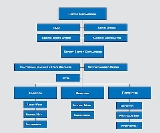
United States Coast Guard Sectors
Encyclopedia
A Sector is a shore-based operational unit of the United States Coast Guard
. Each Sector is responsible for the execution of all Coast Guard missions within its Area of Responsibility (AOR), with operational support from Coast Guard Cutters
and Air Stations
. Subordinate commands within a Sector typically include Stations and Aids-to-Navigation (ATON) Teams. Some Sector commands also have subordinate units such as Sector Field Offices and Marine Safety Units that are responsible for mission execution in parts of the Sector's AOR. There are 35 sectors within the Coast Guard.
in the aftermath of the 9/11 attacks
.
Before 2004, field operations in a single port fell under multiple, mission-based commands (Group, MSO, and VTS) that were physically dispersed, had unique chains of command and different program managers at Coast Guard Headquarters, lacked a consistent voice to the public, and had some mission overlap. The attacks of September 11 called for a new Coast Guard unity of effort that was cumbersome to achieve using the previous multiple command port-level structure. The Coast Guard’s move from the Department of Transportation
to the Department of Homeland Security
and implementation of the Maritime Transportation Security Act of 2002 (MTSA) provided further impetus to restructure.
In 2003, the Coast Guard began to consolidate field activities for its Commercial Vessel Safety, Port and Environmental Safety, Marine Environmental Response, Port Security, Waterways Management, Bridge Administration, Search and Rescue (SAR), Recreational Boating Safety missions under one local Sector Command. The organizational change to Sectors eliminated the historical segregation of prevention and response activities at the local level and created a comprehensive unit that brings together field activities, authorities, and resources to provide the most effective organization and the best value to the public.
The Sector Command combines responsibilities and authorities previously shared by two or more commands into a single operational unit with a command and senior staff of highly competent experts.
The Coast Guard Sector provides for rapid, coordinated response to emergencies, whether natural (such as Hurricane Katrina) or man-made, along with integrated daily operations to enforce regulations governing marine safety, security, and environmental protection. In addition, it provides an immediate safety and security assessment at the onset of any maritime event, disaster, or casualty affords critical synergy to operations essential to marine safety, security, and environmental protection.
Coast Guard Sectors serve as one-stop-shops for marine safety, security, and environmental protection for major seaports and regions. They bring multi-mission capabilities to life on the front lines of the maritime environment, where Sector Commanders are actually allocated some authority equal to District Commanders.
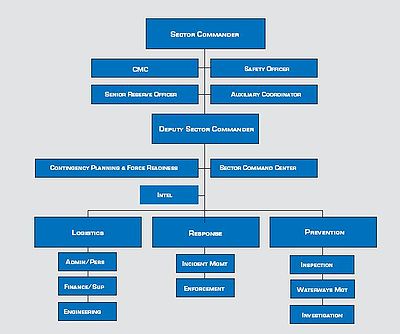 The Sector organizational construct represents a transformation from a Coast Guard traditionally organized around its operational programs to one organized around core operational service delivery processes. It focuses the coordinated efforts of all assigned operational capabilities to accomplish Coast Guard mission objectives.
The Sector organizational construct represents a transformation from a Coast Guard traditionally organized around its operational programs to one organized around core operational service delivery processes. It focuses the coordinated efforts of all assigned operational capabilities to accomplish Coast Guard mission objectives.
and is usually the rank of Captain (O-6). The Sector Commander holds the positions of Captain of the Port
(COTP) and Federal Maritime Security Coordinator (FMSC). Unless otherwise assigned, the Sector Commander is also the Officer in Charge Marine Inspections (OCMI), Search and Rescue Mission Coordinator (SMC), and Federal On-Scene Coordinator
(FOSC). The Sector Commander reports to the appropriate District Commander.http://a257.g.akamaitech.net/7/257/2422/06jun20041800/edocket.access.gpo.gov/2004/pdf/04-17686.pdf
United States Coast Guard
The United States Coast Guard is a branch of the United States Armed Forces and one of the seven U.S. uniformed services. The Coast Guard is a maritime, military, multi-mission service unique among the military branches for having a maritime law enforcement mission and a federal regulatory agency...
. Each Sector is responsible for the execution of all Coast Guard missions within its Area of Responsibility (AOR), with operational support from Coast Guard Cutters
United States Coast Guard Cutter
Cutter is the term used by the United States Coast Guard for its commissioned vessels. A Cutter is or greater in length, has a permanently assigned crew, and has accommodations for the crew to live aboard...
and Air Stations
United States Coast Guard Air Stations
A Coast Guard Air Station provides aviation support for the United States Coast Guard. The Coast Guard operates approximately 210 aircraft from 24 Coast Guard Air Stations in the United States. Fixed-wing aircraft, such as the HC 130 Hercules built for long range missions operate from air stations...
. Subordinate commands within a Sector typically include Stations and Aids-to-Navigation (ATON) Teams. Some Sector commands also have subordinate units such as Sector Field Offices and Marine Safety Units that are responsible for mission execution in parts of the Sector's AOR. There are 35 sectors within the Coast Guard.
History
Sectors replaced Coast Guard Groups, Marine Safety Offices (MSO), Activities, and Vessel Traffic Services (VTS). Previously, a Group and its units provided Search and Rescue (SAR), maritime law enforcement, recreational boating safety, and maintained aids to navigation. MSOs enforced federal laws and regulations related to the safety and security of vessels, port facilities, and the marine environment, and assisted other law enforcement agencies. The new Sector organizations are based on the Activities prototype commands established in 1996 in New York and Baltimore, and (later) San Diego. The Activities units were praised for their efficiency and unity of effortUnity of effort
Unity of effort is the state of harmonizing efforts among multiple organizations working towards a similar objective. This prevents organizations from working at cross purposes and it reduces duplication of effort. Multiple organizations can achieve unity of effort through shared common objectives...
in the aftermath of the 9/11 attacks
September 11, 2001 attacks
The September 11 attacks The September 11 attacks The September 11 attacks (also referred to as September 11, September 11th or 9/119/11 is pronounced "nine eleven". The slash is not part of the pronunciation...
.
Before 2004, field operations in a single port fell under multiple, mission-based commands (Group, MSO, and VTS) that were physically dispersed, had unique chains of command and different program managers at Coast Guard Headquarters, lacked a consistent voice to the public, and had some mission overlap. The attacks of September 11 called for a new Coast Guard unity of effort that was cumbersome to achieve using the previous multiple command port-level structure. The Coast Guard’s move from the Department of Transportation
United States Department of Transportation
The United States Department of Transportation is a federal Cabinet department of the United States government concerned with transportation. It was established by an act of Congress on October 15, 1966, and began operation on April 1, 1967...
to the Department of Homeland Security
United States Department of Homeland Security
The United States Department of Homeland Security is a cabinet department of the United States federal government, created in response to the September 11 attacks, and with the primary responsibilities of protecting the territory of the United States and protectorates from and responding to...
and implementation of the Maritime Transportation Security Act of 2002 (MTSA) provided further impetus to restructure.
In 2003, the Coast Guard began to consolidate field activities for its Commercial Vessel Safety, Port and Environmental Safety, Marine Environmental Response, Port Security, Waterways Management, Bridge Administration, Search and Rescue (SAR), Recreational Boating Safety missions under one local Sector Command. The organizational change to Sectors eliminated the historical segregation of prevention and response activities at the local level and created a comprehensive unit that brings together field activities, authorities, and resources to provide the most effective organization and the best value to the public.
The Sector Command combines responsibilities and authorities previously shared by two or more commands into a single operational unit with a command and senior staff of highly competent experts.
The Coast Guard Sector provides for rapid, coordinated response to emergencies, whether natural (such as Hurricane Katrina) or man-made, along with integrated daily operations to enforce regulations governing marine safety, security, and environmental protection. In addition, it provides an immediate safety and security assessment at the onset of any maritime event, disaster, or casualty affords critical synergy to operations essential to marine safety, security, and environmental protection.
Coast Guard Sectors serve as one-stop-shops for marine safety, security, and environmental protection for major seaports and regions. They bring multi-mission capabilities to life on the front lines of the maritime environment, where Sector Commanders are actually allocated some authority equal to District Commanders.
Organization

Sector Commander
The commanding officer of a Sector is called the Sector CommanderSector Commander
Sector Commander is the position title of the commanding officer of a United States Coast Guard Sector, usually of the rank of Captain . The Sector Commander's second-in-command is the Deputy Sector Commander...
and is usually the rank of Captain (O-6). The Sector Commander holds the positions of Captain of the Port
Captain of the Port
The Captain of the Port is an official who has different functions in the United Kingdom and the United States.-United Kingdom:In the Royal Navy, the Captain of the Port is the officer, usually with the rank of Captain, responsible for the day-to-day running of a Naval Dockyard under the authority...
(COTP) and Federal Maritime Security Coordinator (FMSC). Unless otherwise assigned, the Sector Commander is also the Officer in Charge Marine Inspections (OCMI), Search and Rescue Mission Coordinator (SMC), and Federal On-Scene Coordinator
Federal On Scene Coordinator
The Federal On Scene Coordinator , is a designation in the United States for an individual that:*Is responsible for providing access to federal resources and technical assistance...
(FOSC). The Sector Commander reports to the appropriate District Commander.http://a257.g.akamaitech.net/7/257/2422/06jun20041800/edocket.access.gpo.gov/2004/pdf/04-17686.pdf
Command Staff
The Sector Commander's second-in-command is the Deputy Sector Commander. Also reporting directly to the Sector Commander are the:- Command Master ChiefCommand Master Chief Petty Officer-Background:First referenced in OPNAVINST 1306.2C dated 16 October 1995, the Navy's Command Master Chief Program is a valuable asset which stimulates free-flowing communications and ensures the highest standards of professionalism are upheld at all levels within the chain of command...
(CMC) - Senior ReserveUnited States Coast Guard ReserveThe United States Coast Guard Reserve is the reserve component of the United States Coast Guard. It is organized, trained, administered, and supplied under the direction of the Commandant of the Coast Guard through the Director of Reserve and Leadership....
Officer - AuxiliaryUnited States Coast Guard AuxiliaryThe United States Coast Guard Auxiliary is the uniformed volunteer component of the United States Coast Guard and was established on June 23, 1939 by an act of Congress as the United States Coast Guard Reserve, and was re-designated as the United States Coast Guard Auxiliary on February 19, 1941...
Coordinator
Command Center
The Sector Command Center (SCC) is the center of Sector Operations. It provides 24-hour command, control, coordination, communications, intelligence, sensor analysis, and data mining (C4ISM). The SCC coordinates with other federal, state, and local operations centers, and issues Notices to Mariners, Situation Reports, and maritime security alerts. The SCC displays the current Common Operating Picture (COP) and Common Intelligence Picture (CIP), including a presentation of all vessels, aircraft, communications equipment, and personnel belonging to the Coast Guard and supporting agencies.Contingency Planning and Force Preparedness
The Contingency Planning and Force Readiness Staff develops and maintains plans covering readiness, logistics, and emergency preparedness. It coordinates with the three departments in plan development and execution, and plans and executes readiness exercises to test contingency plans. The Contingency branch also monitors the training and readiness of Sector Reserve Forces and manages their mobilization and demobilization. The Contingency Planning and Force Readiness staff also manages the federally mandated Area and Area Maritime Security Committees around the nation.Intel
The Intelligence Staff is envisioned to collect, evaluate, report, and disseminate operational intelligence within the Sector. This staff will serve as the primary intelligence support element for all operations within the Sector. This staff forwards its analysis of raw intelligence reports to the District and the Atlantic or Pacific Maritime Intelligence Fusion Center, and will be the critical link between the Sector Commander and the entire Coast Guard intelligence enterprise, which is in turn a part of the United States Intelligence Community. http://www.intelligence.gov/1-members_coastguard.shtmlResponse
The Response Department contains two Divisions:- Incident Management Division: Addresses SAR, pollution, and all hazards.
- Enforcement Division: Enforces all laws and treaties and carries out PWCS enforcement activities, such as armed boardings, vessel escorts and security zone enforcement. This division works closely with federal, state, and local law enforcement and sister agencies within the DHS to respond to and mitigate the impact of maritime threats.
Prevention
The Prevention Department consists of three divisions.- Inspections Division: Manages and oversees the regulatory and inspection aspects of the Coast Guard’s safety, security, and environmental protection responsibilities for vessels and facilities.
- Waterways Management Division: Controls aids to navigation; safety and security zones; Regulated Navigation Areas; ice breaking; and VTS and AIS.
- Investigations Division: Initiates inquiries into marine casualties, pollution, boating violations, and assessment of civil penalties.
Logistics
The Logistics Department performs unit level maintenance and organic engineering, personnel, medical support, and finance/supply functions for the entire Sector.- Engineering/Support Division: Administers electronics and computer system, naval, aviation, vehicle, and facilities engineering; armory and small arms qualification; and environmental compliance. The associated Integrated Support Command or Aircraft Repair and Supply Center handle intermediate and depot level maintenance.
- Administrative/Personnel Division: Handles medical, training, housing, and educational services.
- Finance/Supply Division: Encompasses galley, transportation, and property and inventory management.
List of Coast Guard Sectors
Atlantic Area
| District | District Logo | Sector | Location of Sector command |
|---|---|---|---|
| District One | 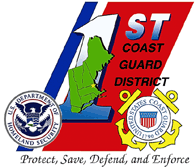 |
Sector Northern New England | South Portland, Maine South Portland, Maine South Portland is a city in Cumberland County, Maine, United States, and is the fourth-largest city in the state. Founded in 1895, as of the 2010 census, the city population was 25,002. Known for its working waterfront, South Portland is situated on Portland Harbor and overlooks the skyline of... |
| Sector Boston | Boston, Massachusetts | ||
| Sector Southeast New England | Woods Hole, Massachusetts Woods Hole, Massachusetts Woods Hole is a census-designated place in the town of Falmouth in Barnstable County, Massachusetts, United States. It lies at the extreme southwest corner of Cape Cod, near Martha's Vineyard and the Elizabeth Islands... |
||
| Sector Long Island Sound | New Haven, Connecticut New Haven, Connecticut New Haven is the second-largest city in Connecticut and the sixth-largest in New England. According to the 2010 Census, New Haven's population increased by 5.0% between 2000 and 2010, a rate higher than that of the State of Connecticut, and higher than that of the state's five largest cities, and... |
||
| Sector New York | Staten Island, New York Staten Island Staten Island is a borough of New York City, New York, United States, located in the southwest part of the city. Staten Island is separated from New Jersey by the Arthur Kill and the Kill Van Kull, and from the rest of New York by New York Bay... |
||
| District Five |  |
Sector Delaware Bay | Philadelphia, Pennsylvania Philadelphia, Pennsylvania Philadelphia is the largest city in the Commonwealth of Pennsylvania and the county seat of Philadelphia County, with which it is coterminous. The city is located in the Northeastern United States along the Delaware and Schuylkill rivers. It is the fifth-most-populous city in the United States,... |
| Sector Baltimore | Baltimore, Maryland | ||
| Sector Hampton Roads | Portsmouth, Virginia Portsmouth, Virginia Portsmouth is located in the Hampton Roads metropolitan area of the U.S. Commonwealth of Virginia. As of 2010, the city had a total population of 95,535.The Norfolk Naval Shipyard, often called the Norfolk Navy Yard, is a historic and active U.S... |
||
| Sector North Carolina | Atlantic Beach, North Carolina Atlantic Beach, North Carolina -Demographics:As of the census of 2008, there were 1,815 people, 971 households, and 498 families residing in the town. The population density was . There were 4,728 housing units at an average density of 2,206.0 per square mile... |
||
| District Seven | 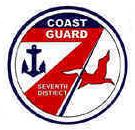 |
Sector Charleston | Charleston, South Carolina Charleston, South Carolina Charleston is the second largest city in the U.S. state of South Carolina. It was made the county seat of Charleston County in 1901 when Charleston County was founded. The city's original name was Charles Towne in 1670, and it moved to its present location from a location on the west bank of the... |
| Sector Jacksonville | Jacksonville, Florida Jacksonville, Florida Jacksonville is the largest city in the U.S. state of Florida in terms of both population and land area, and the largest city by area in the contiguous United States. It is the county seat of Duval County, with which the city government consolidated in 1968... |
||
| Sector Miami | Miami, Florida Miami, Florida Miami is a city located on the Atlantic coast in southeastern Florida and the county seat of Miami-Dade County, the most populous county in Florida and the eighth-most populous county in the United States with a population of 2,500,625... |
||
| Sector Key West | Key West, Florida Key West, Florida Key West is a city in Monroe County, Florida, United States. The city encompasses the island of Key West, the part of Stock Island north of U.S. 1 , Sigsbee Park , Fleming Key , and Sunset Key... |
||
| Sector St. Petersburg | St. Petersburg, Florida St. Petersburg, Florida St. Petersburg is a city in Pinellas County, Florida, United States. It is known as a vacation destination for both American and foreign tourists. As of 2008, the population estimate by the U.S. Census Bureau is 245,314, making St... |
||
| Sector San Juan | San Juan, Puerto Rico San Juan, Puerto Rico San Juan , officially Municipio de la Ciudad Capital San Juan Bautista , is the capital and most populous municipality in Puerto Rico, an unincorporated territory of the United States. As of the 2010 census, it had a population of 395,326 making it the 46th-largest city under the jurisdiction of... |
||
| District Eight | 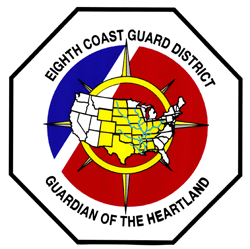 |
Sector Ohio Valley | Louisville, Kentucky Louisville, Kentucky Louisville is the largest city in the U.S. state of Kentucky, and the county seat of Jefferson County. Since 2003, the city's borders have been coterminous with those of the county because of a city-county merger. The city's population at the 2010 census was 741,096... |
| Sector Upper Mississippi | St. Louis, Missouri St. Louis, Missouri St. Louis is an independent city on the eastern border of Missouri, United States. With a population of 319,294, it was the 58th-largest U.S. city at the 2010 U.S. Census. The Greater St... |
||
| Sector Lower Mississippi | Memphis, Tennessee Memphis, Tennessee Memphis is a city in the southwestern corner of the U.S. state of Tennessee, and the county seat of Shelby County. The city is located on the 4th Chickasaw Bluff, south of the confluence of the Wolf and Mississippi rivers.... |
||
| Sector Mobile | Mobile, Alabama Mobile, Alabama Mobile is the third most populous city in the Southern US state of Alabama and is the county seat of Mobile County. It is located on the Mobile River and the central Gulf Coast of the United States. The population within the city limits was 195,111 during the 2010 census. It is the largest... |
||
| Sector New Orleans | New Orleans, Louisiana New Orleans, Louisiana New Orleans is a major United States port and the largest city and metropolitan area in the state of Louisiana. The New Orleans metropolitan area has a population of 1,235,650 as of 2009, the 46th largest in the USA. The New Orleans – Metairie – Bogalusa combined statistical area has a population... |
||
| Sector Houston-Galveston | Houston, Texas Houston, Texas Houston is the fourth-largest city in the United States, and the largest city in the state of Texas. According to the 2010 U.S. Census, the city had a population of 2.1 million people within an area of . Houston is the seat of Harris County and the economic center of , which is the ... |
||
| Sector Corpus Christi | Corpus Christi, Texas Corpus Christi, Texas Corpus Christi is a coastal city in the South Texas region of the U.S. state of Texas. The county seat of Nueces County, it also extends into Aransas, Kleberg, and San Patricio counties. The MSA population in 2008 was 416,376. The population was 305,215 at the 2010 census making it the... |
||
| District Nine | 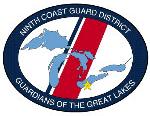 |
Sector Buffalo | Buffalo, New York Buffalo, New York Buffalo is the second most populous city in the state of New York, after New York City. Located in Western New York on the eastern shores of Lake Erie and at the head of the Niagara River across from Fort Erie, Ontario, Buffalo is the seat of Erie County and the principal city of the... |
| Sector Detroit | Detroit, Michigan Detroit, Michigan Detroit is the major city among the primary cultural, financial, and transportation centers in the Metro Detroit area, a region of 5.2 million people. As the seat of Wayne County, the city of Detroit is the largest city in the U.S. state of Michigan and serves as a major port on the Detroit River... |
||
| Sector Lake Michigan | Milwaukee, Wisconsin Milwaukee, Wisconsin Milwaukee is the largest city in the U.S. state of Wisconsin, the 28th most populous city in the United States and 39th most populous region in the United States. It is the county seat of Milwaukee County and is located on the southwestern shore of Lake Michigan. According to 2010 census data, the... |
||
| Sector Sault Ste. Marie | Sault Ste. Marie, Michigan Sault Ste. Marie, Michigan Sault Ste. Marie is a city in and the county seat of Chippewa County in the U.S. state of Michigan. It is in the north-eastern end of Michigan's Upper Peninsula, on the Canadian border, separated from its twin city of Sault Ste. Marie, Ontario, by the St. Marys River... |
Pacific Area
| District | District Logo | Sector | Location of Sector command |
|---|---|---|---|
| District Eleven | 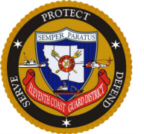 |
Sector San Francisco | San Francisco, California San Francisco, California San Francisco , officially the City and County of San Francisco, is the financial, cultural, and transportation center of the San Francisco Bay Area, a region of 7.15 million people which includes San Jose and Oakland... |
| Sector Los Angeles - Long Beach | San Pedro, California | ||
| Sector San Diego | San Diego, California San Diego, California San Diego is the eighth-largest city in the United States and second-largest city in California. The city is located on the coast of the Pacific Ocean in Southern California, immediately adjacent to the Mexican border. The birthplace of California, San Diego is known for its mild year-round... |
||
| District Thirteen | |
Sector Puget Sound | Seattle, Washington Seattle, Washington Seattle is the county seat of King County, Washington. With 608,660 residents as of the 2010 Census, Seattle is the largest city in the Northwestern United States. The Seattle metropolitan area of about 3.4 million inhabitants is the 15th largest metropolitan area in the country... |
| Sector Columbia River | Astoria, Oregon Astoria, Oregon Astoria is the county seat of Clatsop County, Oregon, United States. Situated near the mouth of the Columbia River, the city was named after the American investor John Jacob Astor. His American Fur Company founded Fort Astoria at the site in 1811... |
||
| District Fourteen |  |
Sector Honolulu | Honolulu, Hawaii Honolulu, Hawaii Honolulu is the capital and the most populous city of the U.S. state of Hawaii. Honolulu is the southernmost major U.S. city. Although the name "Honolulu" refers to the urban area on the southeastern shore of the island of Oahu, the city and county government are consolidated as the City and... |
| Sector Guam | Guam Guam Guam is an organized, unincorporated territory of the United States located in the western Pacific Ocean. It is one of five U.S. territories with an established civilian government. Guam is listed as one of 16 Non-Self-Governing Territories by the Special Committee on Decolonization of the United... |
||
| District Seventeen | 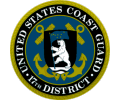 |
Sector Anchorage | Anchorage, Alaska Anchorage, Alaska Anchorage is a unified home rule municipality in the southcentral part of the U.S. state of Alaska. It is the northernmost major city in the United States... |
| Sector Juneau | Juneau, Alaska Juneau, Alaska The City and Borough of Juneau is a unified municipality located on the Gastineau Channel in the panhandle of the U.S. state of Alaska. It has been the capital of Alaska since 1906, when the government of the then-District of Alaska was moved from Sitka as dictated by the U.S. Congress in 1900... |
See also
- United States Coast GuardUnited States Coast GuardThe United States Coast Guard is a branch of the United States Armed Forces and one of the seven U.S. uniformed services. The Coast Guard is a maritime, military, multi-mission service unique among the military branches for having a maritime law enforcement mission and a federal regulatory agency...
- Organization of the United States Coast GuardOrganization of the United States Coast GuardThis article covers the organization of the United States Coast Guard.The headquarters of the Coast Guard is on 2100 Second Street, SW, in Washington, DC. The Coast Guard announced plans to relocate to the grounds of the former St. Elizabeths Hospital in Washington...
- U.S. Coast Guard CuttersUnited States Coast Guard CutterCutter is the term used by the United States Coast Guard for its commissioned vessels. A Cutter is or greater in length, has a permanently assigned crew, and has accommodations for the crew to live aboard...
- U.S. Coast Guard Air StationsUnited States Coast Guard Air StationsA Coast Guard Air Station provides aviation support for the United States Coast Guard. The Coast Guard operates approximately 210 aircraft from 24 Coast Guard Air Stations in the United States. Fixed-wing aircraft, such as the HC 130 Hercules built for long range missions operate from air stations...

